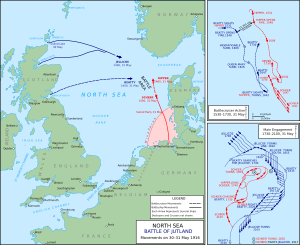Battle of Jutland facts for kids
Quick facts for kids Battle of Jutland |
|||||||
|---|---|---|---|---|---|---|---|
| Part of World War I | |||||||
|
The Battle of Jutland, 1916 |
|||||||
|
|||||||
| Belligerents | |||||||
| Commanders and leaders | |||||||
|
|
||||||
| Strength | |||||||
|
|
||||||
| Casualties and losses | |||||||
|
|
||||||
The Battle of Jutland was the biggest naval battle of World War I. It happened near Denmark in the North Sea. This battle was a major event because it was the only time the main British and German fleets fought directly.
During World War I, the powerful British Royal Navy kept the German fleet mostly stuck in its base at Wilhelmshaven. The Battle of Jutland began when the German fleet, led by Admiral Reinhard Scheer, tried to break out into the open sea.
The German fleet had 22 battleships, five battlecruisers, 11 cruisers, and 61 torpedo-boats. Admiral Scheer also used submarines with torpedos. He placed these submarines near the main British naval bases.
The main British bases were in Scotland. One huge base was at Scapa Flow in the Orkney and Shetland. Other bases were at Cromarty and Rosyth.
The British fleet sailed south-east from their bases. They met the German fleet, which was sailing north. The battle took place over a large area near the Jutland Bank. This area is west of the Skagerrak, a strait between Norway and Denmark.
Contents
How did the British know?
The British fleet was far from the battle area. But they knew the German fleet was coming. This was because the British had secretly broken the German cipher. A cipher is a secret way of writing messages.
When Admiral Scheer gave the order to sail, the British Admiralty in London found out. They quickly ordered their Grand Fleet to sail from the Orkneys.
The British got their hands on three German code books. One book for smaller ships came from a German cargo ship. Another, for secret messages between countries, was found in a sunken ship in the North Sea. The most important code, for the main German fleet, came from a cruiser that sank in the Baltic. These code books gave the British a huge advantage.
What happened in the battle?
The first fight
The first British ships to meet the Germans were from the Firth of Forth. These ships were led by Vice-Admiral David Beatty. Beatty had six battlecruisers and four fast battleships. They safely passed the German submarines near their base.
Beatty's battlecruisers soon met the German battlecruiser force. This German force was led by Rear-Admiral Franz Hipper. The German ships had better range-finding equipment, which helped them shoot more accurately.
However, the British cruisers were saved when their four battleships arrived. These battleships had stronger armor and more powerful guns. Because of this, Admiral Hipper had to turn his ships away. He sailed east towards the main German battleship force.
The main fleets clash
Later that day, the main British fleet arrived. This 'Grand Fleet' was from Scapa Flow and led by Admiral John Jellicoe. They met the main German battleship force, commanded by Admiral Scheer.
It was a very intense fight. One observer said that "the entire arc stretching from the north to the east was a sea of fire." After about ten minutes of heavy firing, Admiral Scheer ordered his ships to turn away all at once.
The British fired 21 torpedoes, which made Admiral Jellicoe also turn his ships away. This allowed Scheer to put about 10 miles between his ships and the British battleships. As it got dark, there were a few more small fights. The German fleet then managed to sail home.
The Germans had sunk more British ships, but the overall strength of the two navies did not change much. The British still had a larger and more powerful fleet.
Outcome of the battle
The Battle of Jutland was a tactical victory for Germany, meaning they sank more ships and caused more damage. However, it was a strategic victory for Britain. The German fleet did not break the British blockade. The British Royal Navy kept control of the North Sea for the rest of the war. This meant Germany could not easily get supplies from other countries.
Images for kids
-
Reinhard Scheer, German fleet commander
-
The Skagerrak, a key waterway near Jutland, Norway, and Sweden
-
HMS Caroline, the last surviving warship from Jutland, preserved in Belfast
See also
 In Spanish: Batalla de Jutlandia para niños
In Spanish: Batalla de Jutlandia para niños


















